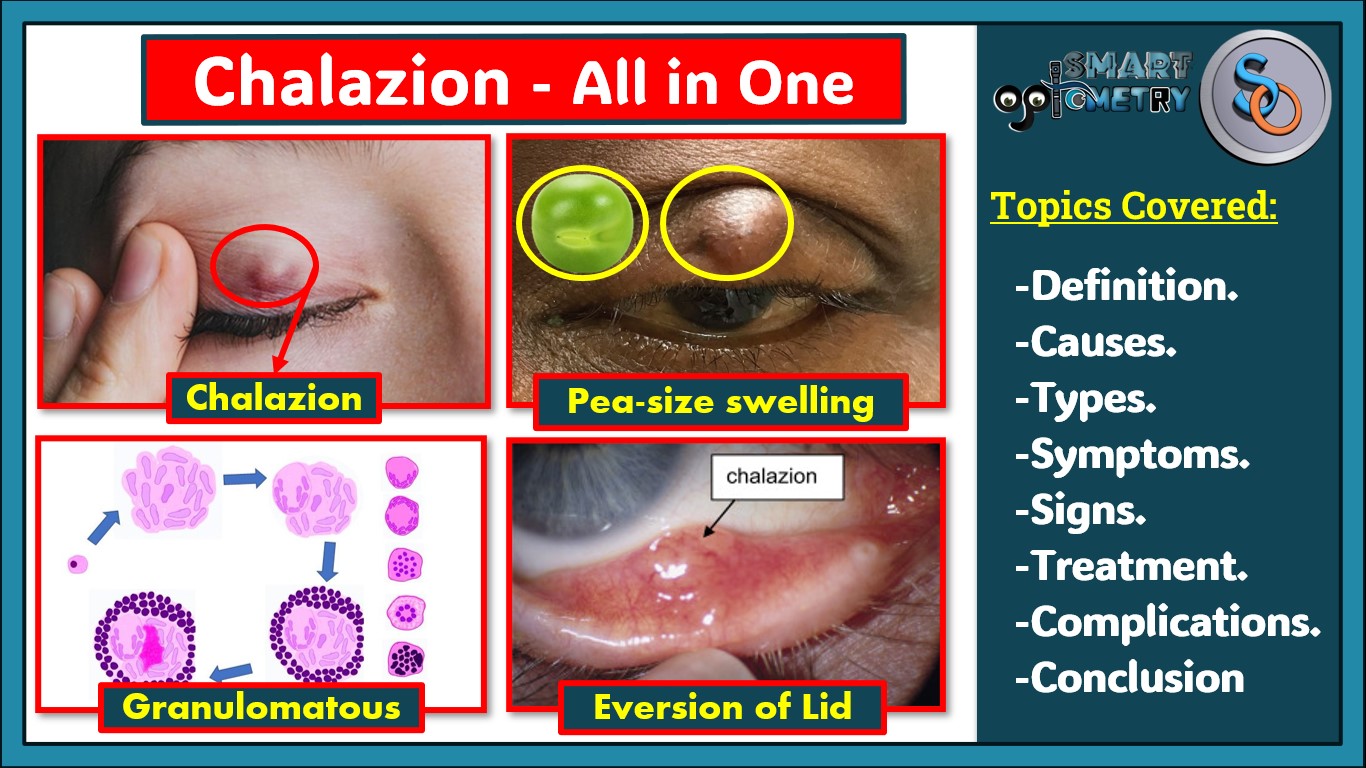What is Chalazion?
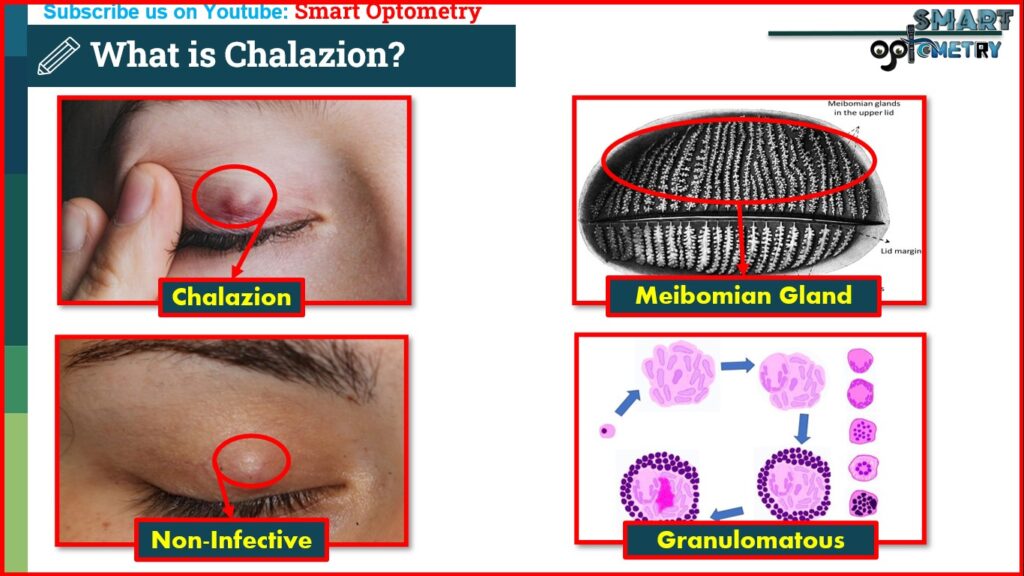
Chalazion is a chronic non-infective granulomatous inflammation of the meibomian gland also called a Tarsal Cyst or Meibomian Cyst.
From the definition 3 things need to be understood:
- Chalazion is associated with Meibomian gland:
- The location of Meibomian gland is Tarsal Plate that in the middle of the eyelid. So, location of Chalazion will be in the middle of the eyelids, not in the lid margin unlike Blepharitis & Stye.
- Chalazion is Non-infective:
- Non-Infective means there won’t be any infection, so there will be no pain or pus formation.
- Chalazion is Granulomatous Inflammation:
- Granulomatous Inflammation means, it occurs due to formation of Granuloma by the immune system of our body to prevent leakage of lipid from Blocked Meibomian Gland.
How does Chalazion Occurs?

- At first a mild grade infection occurs in Meibomian Gland by organisms of low very low virulence.
- This mild grade infection leads to blockage of the Meibomian Gland and the secretion or lipid of Meibomian gland can’t pass that build-up within the gland.
- Continuous secretion of Lipids leads to leakage from Meibomian Gland to surrounding tissues.
- Immune cells gather around the leaked lipid and form a granuloma to prevent leakage, creating the characteristic firm, non-painful lump of a chalazion.
.
.
What are the Causes of Chalazion Formation?
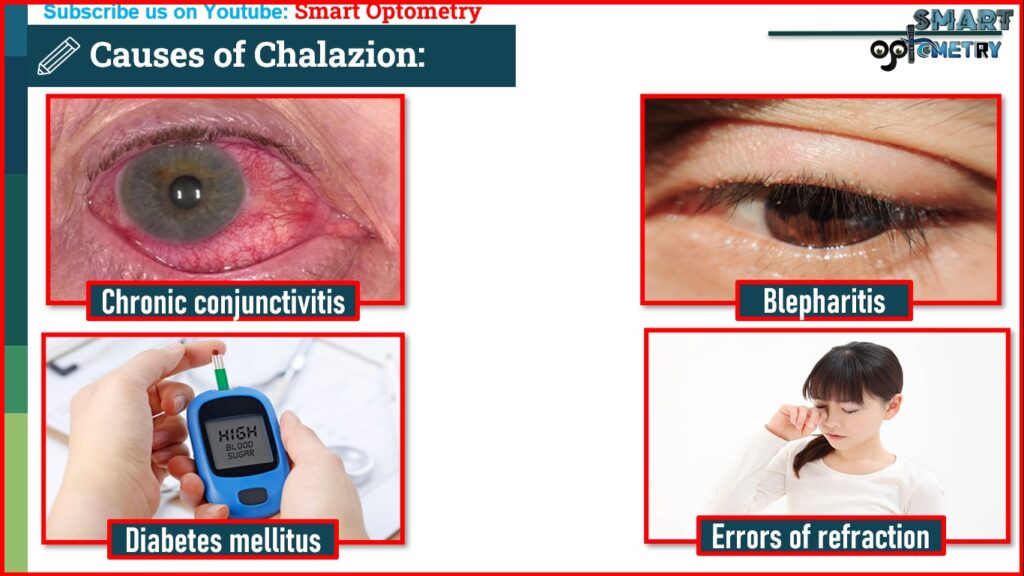
1. Chronic conjunctivitis (e.g., trachoma):
Persistent inflammation in the eye and eyelids from chronic infections like trachoma can cause scarring or blockage of the meibomian ducts, leading to chalazion.
2. Blepharitis:
Chronic eyelid inflammation in blepharitis can obstruct the meibomian glands, resulting in gland secretion buildup and chalazion formation.
3. Children and young adults:
Higher oil gland activity in younger individuals can lead to more frequent blockages in the meibomian glands, increasing the risk of chalazion.
4. Uncontrolled Diabetes mellitus:
Diabetes can impair immune responses and increase glandular secretion thickness, making it easier for meibomian glands to become blocked.
5. Errors of refraction:
Frequent eye rubbing to improve vision in uncorrected refractive errors can lead to chronic eyelid irritation and inflammation, causing meibomian duct obstruction and subsequent chalazion formation.
.
.
What are the Clinical Features of Chalazion?
Symptoms of Chalazion:

- Painless nodular swelling of the eyelid.
- Feeling of mild heaviness.
- Drooping of the eyelid.
Signs of Chalazion:
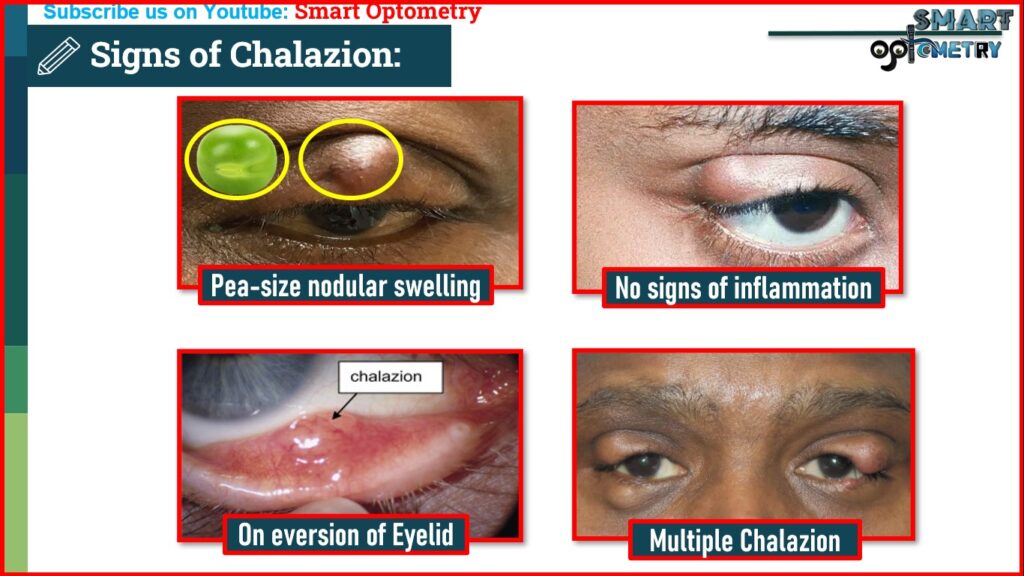
1. A small pea-size nodular swelling:
- Generally, away from the lid margin.
- It is firm, tense and non-tender.
- It usually points on the conjunctival side and rarely in Skin side.
2. No signs of inflammation.
- No pain,
- No local temperature raises,
- No Pus formation.
3. The Skin:
- The Skin over the swelling is normal.
- The skin is free from swelling.
4. On eversion of Eyelid:
The tarsal conjunctiva underneath the nodule is velvety-red or purple, and slightly elevated.
5. Numbers & Locations:
Frequently, multiple chalazion may be seen involving one or more eyelids.
.
.
What Happens if a Chalazion is Left Untreated?
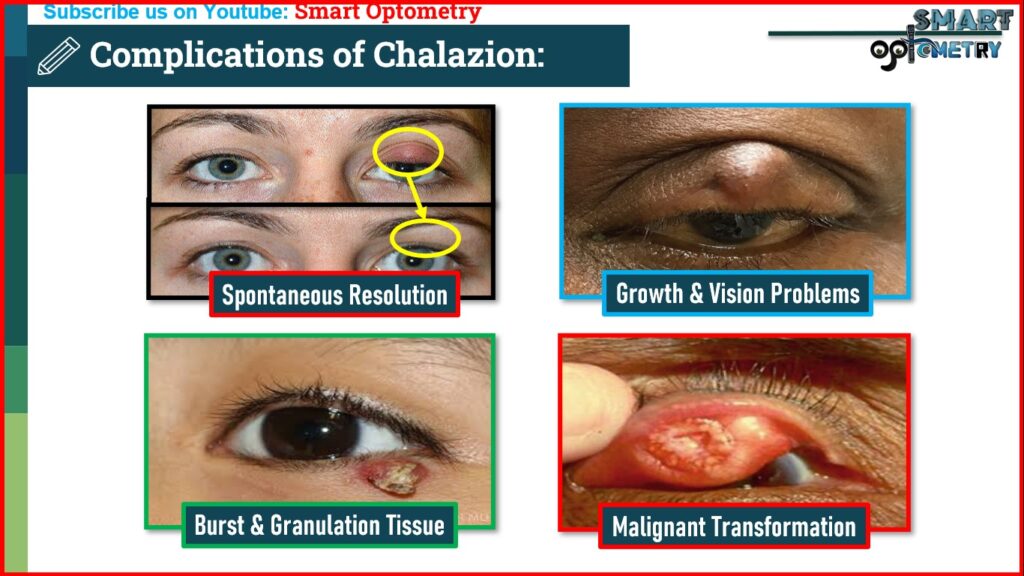
1. Spontaneous Resolution
If left untreated, in rare cases a chalazion may resolve on its own without any treatment.
2. Growth and Vision Problems:
- Chalazion may slowly grow larger.
- A large chalazion on the upper eyelid can press on the cornea, leading to blurred vision due to induced astigmatism.
- Large chalazion on the lower lid may rarely cause eyelid issues like punctal eversion, ectropion, or excessive tearing (epiphora).
3. Burst and Granulation Tissue:
Occasionally, an untreated chalazion may rupture on the inner (conjunctival) side, creating a mass of granulation tissue that can look like a small, raised bump.
4. Secondary Infection:
If infected, an untreated chalazion may develop into an internal hordeolum, causing redness, pain, and swelling.
5. Calcification:
In rare cases, a chronic chalazion can undergo calcification, forming a hard lump.
6. Malignant Transformation:
Very rarely, especially in older adults, an untreated chalazion can lead to malignancy, potentially transforming into a meibomian gland carcinoma.
.
.
What is Treatment of Chalazion?
Treatment of Chalazion can be divided into 4 categories:

- 1. Conservative Treatment
- 2. Intralesional Steroid Injection
- 3. Incision and Curettage
- 4. Diathermy
1. Conservative Treatment:

For small, recent, and soft chalazion, conservative treatment may promote self-resolution. Conservative treatment includes
a. Hot fomentation:
- Hot fomentation softens the clogged oil within the meibomian gland, encouraging natural drainage of the chalazion and reducing swelling.
- Soak a clean cloth in warm (but not hot) water, wring out excess water, and gently press it against the eyelid over the chalazion for about 10–15 minutes. This should be done 3–4 times daily.
b. Topical antibiotic eye drops
- Antibiotic eye drops like: Ciprofloxacin or Moxifloxacin, 3-4 times daily are prescribed to prevent bacterial infection in and around the chalazion.
- Although chalazion is typically not caused by infection, using antibiotics can prevent secondary bacterial infection, which can complicate healing and cause discomfort.
c. Oral anti-inflammatory drugs:
- Inflammatory Drugs like: ibuprofen or naproxen 2 times daily after meal can reduce inflammation and discomfort.
- These medications work systemically to decrease swelling and alleviate discomfort, supporting the natural healing process.
.
.
2. Intralesional Steroid Injection:

- The injection of a long-acting steroid, usually triamcinolone, helps reduce inflammation within the chalazion, promoting its resolution.
- This method is often effective for smaller, softer chalazion and is frequently attempted before surgical intervention.
- This method has about a 50% success rate.
.
.
3. Incision and Curettage:
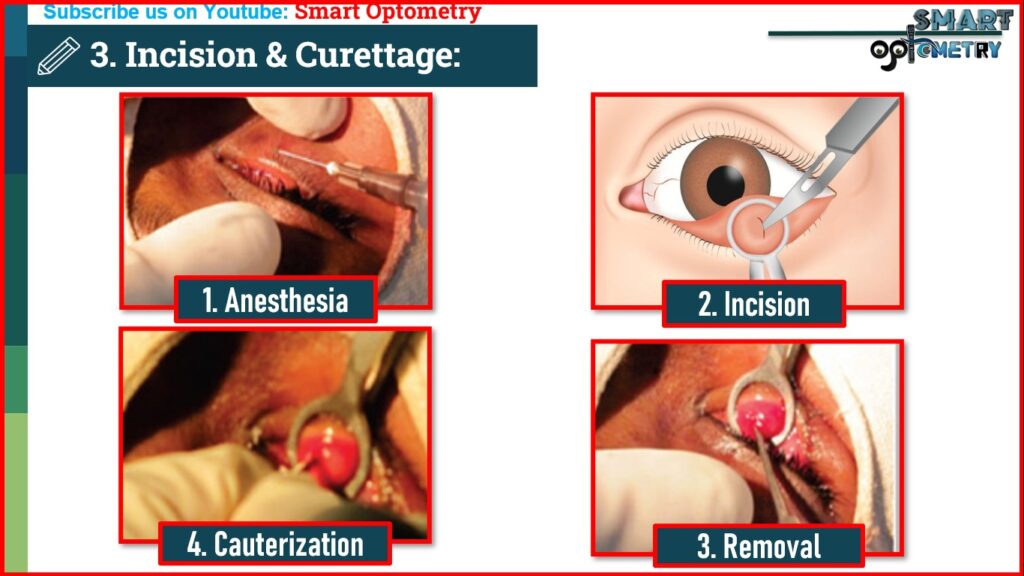
This is the most effective treatment for larger or persistent chalazion.
Procedure:
- After local anesthesia, a small vertical incision is made to avoid visible scarring and protect nearby ducts.
- The contents are then removed using a chalazion scoop, and the cavity is often cauterized to prevent recurrence.
Aftercare:
Antibiotic ointment is applied, and the eye is padded for 12 hours, followed by antibiotics, hot fomentation, and anti-inflammatory medications for 3–4 days.
Procedure:
- After local anesthesia a small vertical incision is made
- On the conjunctival side protect nearby ducts
- Contents are then removed using a chalazion scoop
- The cavity is often cauterized to prevent recurrence.
Aftercare:
- Antibiotic ointment is applied
- The eye is padded for 12 hours.
- Followed by antibiotics, hot fomentation, and anti-inflammatory medications for 3–4 days.
.
.
4. Diathermy
- Diathermy is a technique that uses controlled heat to treat chalazion.
- The heat helps reduce the lesion by coagulating tissue within the chalazion, reducing its size and relieving symptoms.
- Diathermy is preferred for treating chalazion near the eyelid margin, as it uses controlled heat to effectively target and treat the lesion.
- Check Our Courses: Ophthalmic Instrumentation, Clinical Refraction, Contact Lens, Binocular Vision, Dispensing Optics, MCQs in Optometry
- Download our App “Optometry Notes & MCQs” from Google Play Store.

